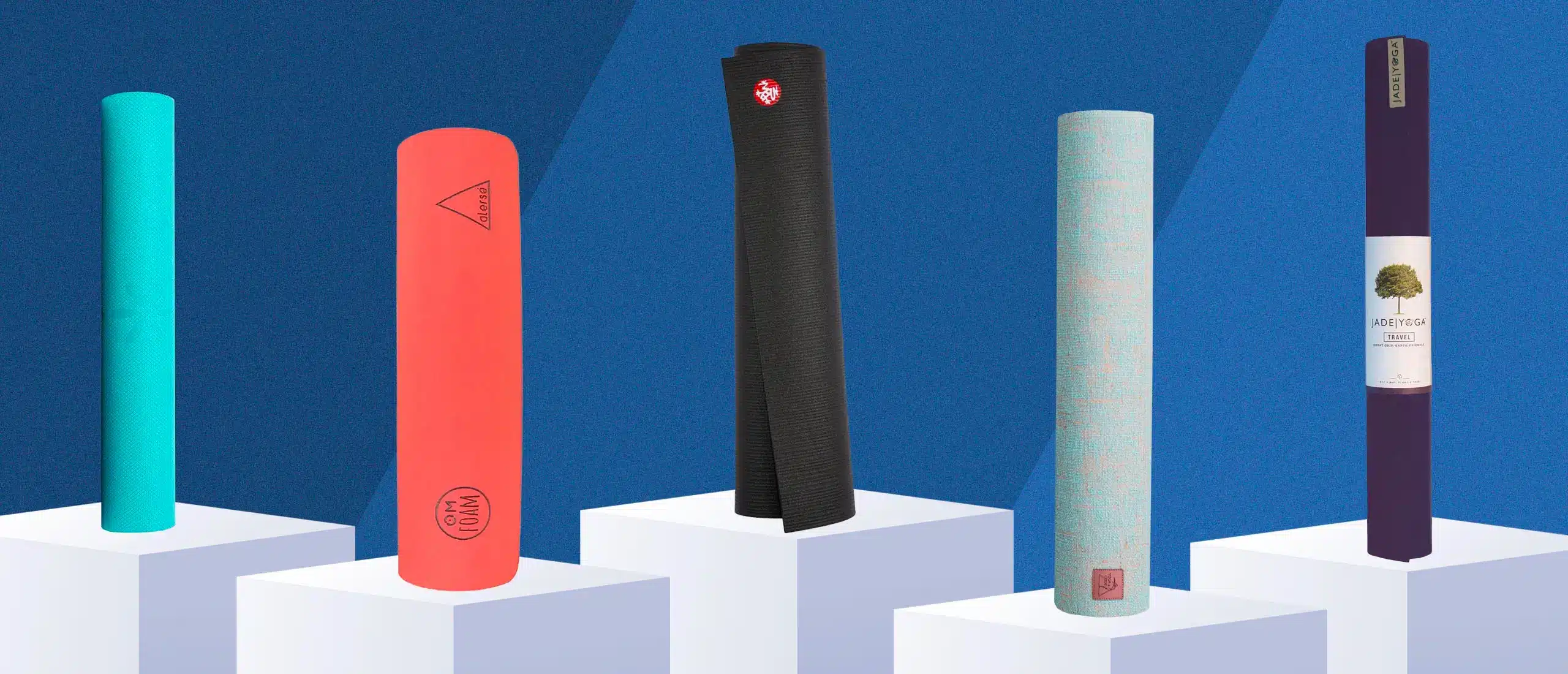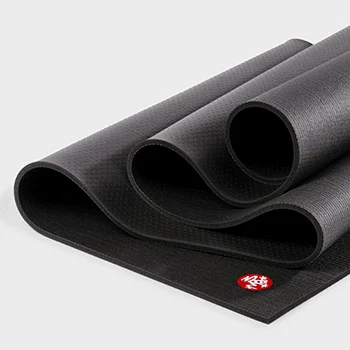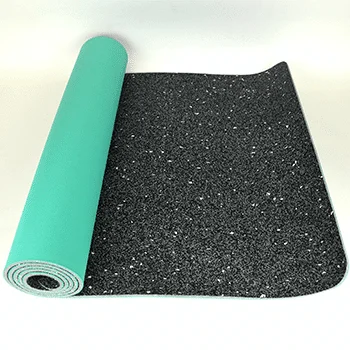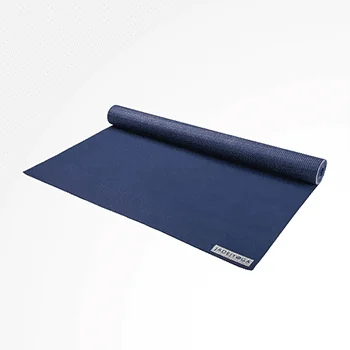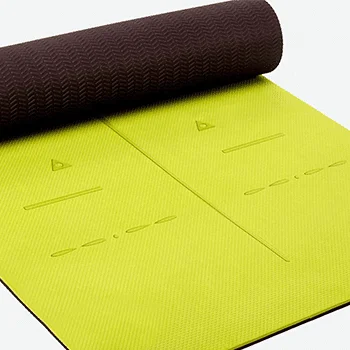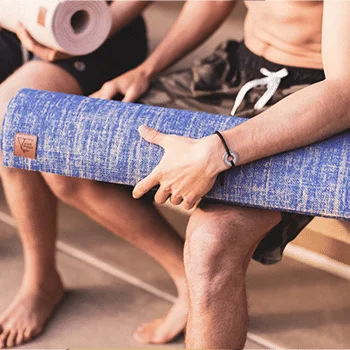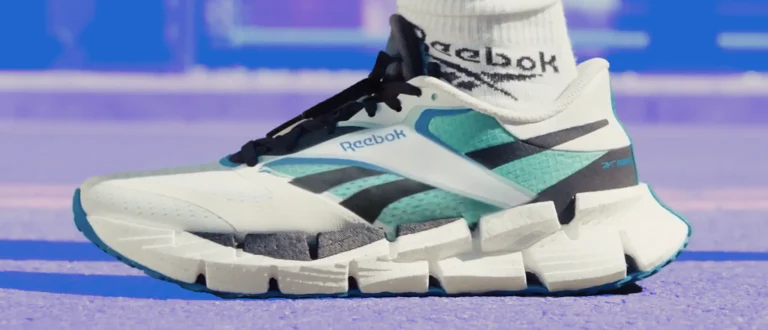Sure, you could do yoga in your squat shorts, on your home gym floor. But if you’re going to pretzel yourself into crow pose, you probably want to invest in proper yoga gear that mitigates injury risk, and keeps you comfortable while sweat is dripping off your nose.
First thing’s first: you’re going to want a joint-cushioning yoga mat with a non-slip finish, so you don’t eat it while moving from flying warrior into high lunge. Don’t know where to start? We’ve got five expert-vetted picks, along with all the reasons why you should invest in one right here.
Are All Yoga Mats Non-Slip?
If you’ve ever gone to hot yoga and felt like you were on a slip-and-slide, you know that not all yoga mats are anti-slip. You would think the first priority in production would be non-slip and cushion, but not all yoga modalities are sweat-inducing, so it’s not necessary all the time.
Whether or not a yoga mat is non-slip depends on the material it’s made of. “PVC mats, for instance, are slippery in the beginning and one needs to break them in to achieve grip. While cotton yoga mats will slide from under you if used on tiled or hard floors,” says Smriti Tuteja, a yoga teacher for yogic-experience.com.
Why Do You Need a Non-Slip Yoga Mat?
The woes of slippery yoga mats are more than just an annoyance—you could be opening yourself up to the possibility of injury. “A slippery yoga mat may make it almost impossible to hold a pose or, in a worse case, may cause you to slip while practicing, leaving you hurt,” warns Tuteja.
Plus, slipping around on your yoga mat detracts from your enjoyment of the practice and the mindfulness benefits associated with yoga. “No one wants to be in down-dog, with both feet and hands slipping until you end up in a plank,” comments Jenni Hackworth, CEO of White Lotus Yoga Studio in Monument, Colorado.
YOU NEED TO STRETCH
The Best Non-Slip Yoga Mats
1. Manduka Pro Yoga Mat
Tuteja’s favorite is the Manduka Pro. She has been using hers for almost four years for its joint- and bone-cushioning thickness (6mm). It’s our pick for anyone over 6 feet tall, because it comes in both a standard length (71 inches) and a long length (85 inches).
- 6mm thickness cushions bones and joints
- Supportive and stable
- Skid-proof backing
- Closed-cell material seals out bacteria and moisture
- Easy to clean
- Comes in two lengths
- Heavier than most mats (7.5 to 9.5lbs)
- Expensive
2. Alerse Thick Yoga Mat
This yoga mat doesn’t mess around. It’s 8mm thick, which is ideal for anyone with bad knees (you won’t even feel the ground if you’re in low lunge). Both the front and back are made to be non-slip—the front is made from the same material found in premium athletic footwear to add extra cushion and grip, while the back is specifically engineered to stay put during your whole practice. Plus, it’s eco-friendly, non-toxic, and made of recycled materials.
- Thickest yoga mat on our list at 8mm
- OmFoam technology provides maximum grip and cushion
- Skid-proof backing
- Made of 75% recycled materials
- Eco-friendly and non-toxic
- Heavier than most mats at 8 pounds
- Expensive
3. Jade Yoga Voyager Mat
The Jade Yoga Voyager Mat tends to be a cult fan favorite—you’ll see a few of these in any yoga class you go to. And for good reason. They’re made of 100 percent recycled rubber, which makes them naturally non-slip and durable. They’re meant for taking on the go—they can fold up to about the size of a yoga block making them extremely portable and easy to stuff in your gym bag. Although it’s not the most durable design, at just $43, it’s one-third of the cost of the above options.
- Ultra lightweight (1.5 pounds)
- Portable design can be folded up to easily fit in a suitcase or gym bag
- Extremely thin at 1.5mm thick
- 68-inch length may be too short for some
- Foldable design makes it less durable than most yoga mats
4. Heath Yoga TPE Alignment mat
If you like the price of Jade Yoga’s Voyager Mat, but want something a bit more substantial in terms of thickness, look no further than the Heath Yoga TPE mat. It’s got 6mm of joint-loving cushion and is free of latex, PVC, or any other toxic materials. But the real draw is this mat’s body alignment lines, which can be used for movement guidance whether you’re a beginner or just looking to level up your practice. We also like to use this mat for functional fitness movements, like squats and lunges, to ensure proper alignment and form. Traction on both sides ensures it wont slip out from under you so you can focus on crushing another Vinyasa.
- Body alignment lines provide movement guidance
- Double layer, 6mm thickness provides optimal cushion
- 72-inch length is ideal for most
- Free of latex, PVC, and heavy metals
- Alignment lines may be distracting to some
5. Yoga4Good Natural Yoga Mat
Yoga4Good’s natural yoga mat is made out of upcycled materials, like jute, which provides non-slip traction to the top of the mat. Jute is a natural grass that just so happens to provide excellent levels of grip, even when you’re sweating up a storm. Not to mention, a portion of the profits goes to the Center for Community Solutions (CCS) in San Diego, California, which provides support to those whose lives have been impacted by sexual violence.
- Natural materials are durable, sweat-resistant, and offer excellent grip
- Free of latex, silicone, and other toxins
- Lightweight yet cushiony on joints
- Not many color options
- Backing isn't skid-proof
- Natural materials aren't as easy to wipe down and could retain smell after use
How Do You Break In a Non-Slip Yoga Mat?
The best way to break in your yoga mat is to (wait for it)…use it. But there are other things you can do to speed up the process. Rafael Aguilo, co-founder and co-creator of the Alerse Yoga Mat recommends wiping your mat down with a damp towel, to remove any residue or dust and to activate the grip of your non-slip yoga mat. “Stay away from harsh soaps or oils on your mat, as those could stay on the material and cause it to get slippery,” he advises. Tuteja also recommends walking over it barefoot to accelerate the breaking-in process if you’re not ready to practice yoga on it just yet.
Many people also enjoy using a yoga towel, which can either be placed on top of your mat to soak up sweat or kept close by to wipe yourself or your mat down as needed. Many yoga towels also add traction to the mat when wet, so they can be a good option before a new mat is broken in. We recommend the LEUS Eco Towel which is antimicrobial, super soft, and extra absorbent.
How Do You Clean a Yoga Mat?
Think about it: you’re stepping all over your mat with bare feet, sweating on it, breathing on it, and more. Lots of dirt and bacteria accumulates on your yoga mat, so yes, you do have to clean it often. Aguilo recommends giving it a good wipe-down with a damp cloth immediately after practicing. “If you need a little more,” he says, “we would recommend a baby wipe.” If you’re going to use soap, use baby soap, not harsh detergents or vinegar, which can both degrade the materials and cause them to break down sooner.

